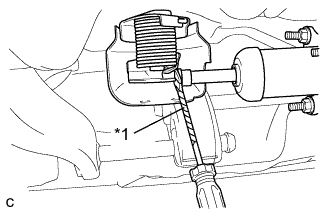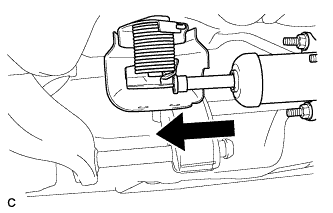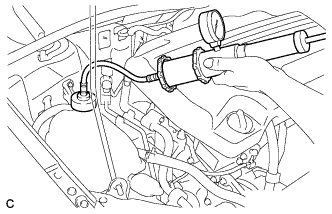EXHAUST HEAT RECIRCULATION SYSTEM > ON-VEHICLE INSPECTION |
| 1. INSPECT FRONT EXHAUST PIPE ASSEMBLY |
Inspect exhaust flow control valve operation.
 |
Using a screwdriver, move the exhaust flow control valve from the bottom of the vehicle. Check that the valve moves smoothly.
| *1 | Protective Tape |
If the valve is stuck or does not move smoothly, replace the front exhaust pipe assembly (Click here).
Inspect the exhaust pipe gas control actuator.
Connect the the intelligent tester to the DLC3.
Turn the power switch on (IG) and turn the tester on.
Enter the following menus: Powertrain / Engine and ECT / Data List / Coolant Temp.
 |
While checking the engine coolant temperature with the the intelligent tester check the operation of the exhaust pipe gas control actuator rod when the temperature rises.
| Condition | Rod Operation |
| Cold (below approx. 71°C (160°F)) → Warmed up (approx. 80°C (176°F) or more) | Rod gradually extends as the temperature rises. |
If the exhaust pipe gas control actuator rod does not move smoothly, replace the exhaust pipe gas control actuator (Click here).
Check for any cracks or damage on the exhaust pipe gas control actuator rod.
If any cracks or damage is found, replace the front exhaust pipe assembly (Click here).
| 2. INSPECT FOR ENGINE COOLANT LEAK FROM FRONT EXHAUST PIPE ASSEMBLY |
Turn the power switch off. Check for engine coolant leaks from the front exhaust pipe assembly and the heater hose around the engine coolant temperature sensor.
 |
Add engine coolant to the radiator and install the radiator cap tester.
Pump it to 108 kPa (1.1 kgf/cm2, 16 psi), then check that the pressure does not drop.
If the reading drops, check for leaks from the front exhaust pipe assembly and the heater hose around the engine coolant temperature sensor.